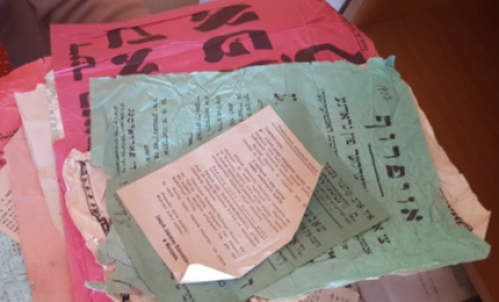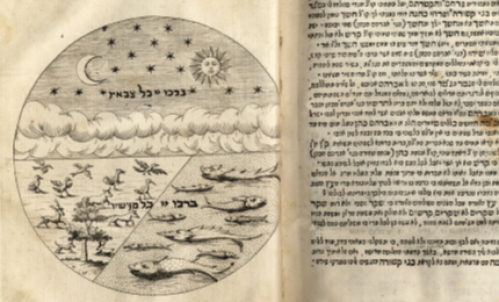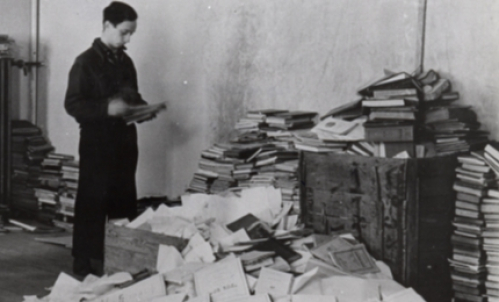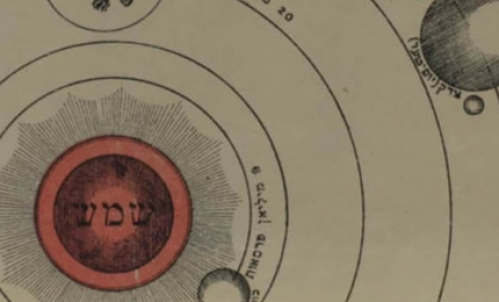YIVO in the U.S.
1940s-1999
In 1947, with the help of the U.S. Army, YIVO managed to recover some of the materials the Nazis had confiscated in Vilna and shipped to Germany. A few other items were smuggled out of Vilna to New York by Abraham Sutzkever, Szmerke Kaczerginski, and other Paper Brigade survivors who had returned to Vilna after the war. As the Soviets began an intensive crackdown on Jewish culture in the late 1940s, however, these activists fled Eastern Europe. Later, it was rumored that the remnants of the YIVO collections left behind had been destroyed by the authorities.
While the materials recovered by YIVO in Germany represented only a fraction of its prewar archives and library, they served as the basis for rebuilding YIVO in the United States. The Institute continued to collect books, journals, documents, photographs, films, and other artifacts. By the late 1980s, the YIVO library held about 320,000 books and periodicals, and the Archives estimated its holdings at 24 million items. Today, YIVO remains the foremost collection of materials related to East European Jewish history and culture and Yiddish language and literature. The Library and Archives also have important collections related to the Holocaust and American Jewish history.
Even during the war, YIVO in New York had managed to carry on as much of its prewar scholarly endeavors as possible. YIVO began publishing Yidishe shprakh (Yiddish Language), a Yiddish linguistics journal in 1941, and in 1944 mounted an exhibition, Pictures of Jewish Life in Prewar Poland, the first public show of photographer Roman Vishniac's work.
Over the next few decades, YIVO continued to publish important scholarly works. It revived YIVO-bleter, its Yiddish-language scholarly journal, and began to issue the English-language YIVO Annual of Jewish Social Science. In 1949, it published Uriel Weinreich's College Yiddish, a textbook that is still in use in many university-level Yiddish courses. Publication of additional resources for the study of Yiddish followed.
YIVO held yearly scholarly conferences. Hundreds of students passed through its intensive summer Yiddish program, the Uriel Weinreich Program in Yiddish Language, Literature, and Culture, and the graduate seminars of its Max Weinreich Center for Advanced Jewish Studies.
In keeping with Vilna YIVO's original mission to serve as a cultural resource for the Jewish people, New York YIVO initiated many programs, some of which were aimed at non-scholarly audiences. It mounted exhibitions, co-sponsored the First New York Yiddish Film Festival in 1977, produced a documentary film, Image Before My Eyes, in 1981, and inaugurated a Yiddish folk arts program with workshops in Yiddish music, dance, and folk art in 1985.
21st Century
In 1999, YIVO moved into its fifth American home, the Center for Jewish History, at 15 West 16th Street in New York City, where it shares a reading room, a state-of-the-art auditorium, and exhibition galleries with five other organizations. The new facility has made possible a greatly expanded program of cultural and educational events, including symposia and concerts.
Since its move to the Center, YIVO has embarked on a number of new initiatives designed to create greater access to its resources, including ongoing digitization of its collections and the digitization of its library catalog. A milestone in this area was reached in early 2013, with the launch of an online Guide to the YIVO Archives. In 2008, YIVO and Yale University Press published a major reference work, the two-volume The YIVO Encyclopedia of Jews in Eastern Europe, which became available online two years later.
YIVO has continued actively collecting library and archival materials. In 2013, YIVO and the National Library of Israel jointly acquired the estate of the late Yiddish writer, Chaim Grade.
In 1989, YIVO received dramatic news—some of its manuscripts and books long thought destroyed by the Nazis and Soviets had been hidden by idealistic Lithuanian librarians in a back room of the Lithuanian National Book Chamber. In 2015, after years of negotiations with the Lithuanian government, YIVO launched the Edward Blank YIVO Vilna Online Collections project, an international initiative to reunite these materials with the part of its collections it was able to recover right after the war.



